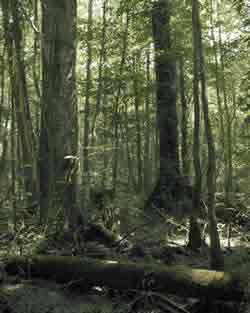Characteristic Mid-Atlantic Wetland Type - White Cedar Swamp

White Cedar Swamp at Great Dismal Swamp National Wildlife Refuge. Credit: Fish & Wildlife Service Atlantic white cedar swamps are a rare habitat found in low-lying, isolated patches along a 50-130 mile stretch of the eastern seaboard and Gulf Coast. The Atlantic white cedar grows in small, dense stands in wet, acidic soils with high levels of organic matter. Because its seedlings do not grow well in shade, this slow-growing tree typically thrives in open bogs. The roots of the tree are usually covered in sphagnum moss, and the standing freshwater in these swamps is dark, tinted by tannins. While white cedars usually grow on slightly elevated hummocks, they typically are surrounded by hollows where water-which may be present throughout the growing season-can stand up to 4 feet deep or as low as 1 foot below the surface. Stands of Atlantic white cedar also require periodic wildfires that eliminate shade-causing brush and shrubs. |
National InformationCharacteristic Wetland Types for the Mid-Atlantic Region
Notable Wetland Sites in the Mid-Atlantic Region
|
![[logo] US EPA](../gif/logo_epaseal.gif)